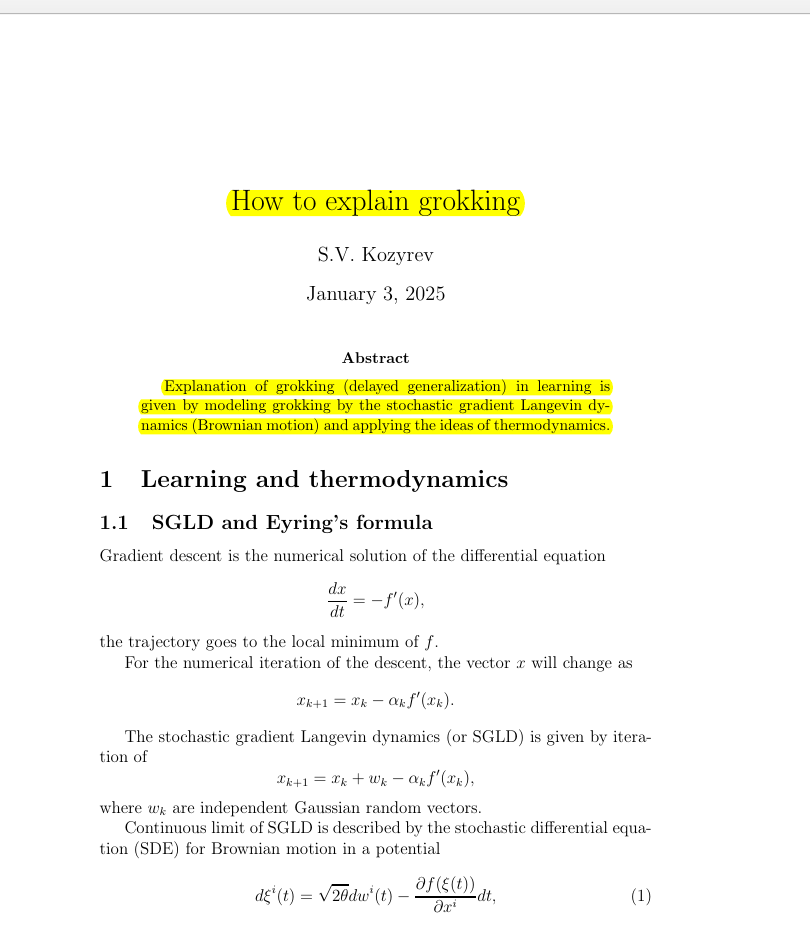"How to explain grokking"
Below podcast on this paper is generated with Google's Illuminate.
https://arxiv.org/abs/2412.18624
The paper addresses the problem of grokking in neural networks. Grokking is when a model initially memorizes training data and overfits, but later, after prolonged training, it suddenly generalizes well to unseen data.
This paper proposes to explain grokking using concepts from thermodynamics and stochastic gradient Langevin dynamics. It suggests that grokking is a process of transitioning from sharp minima (memorization) to flat minima (generalization) in the loss landscape, driven by entropy maximization.
-----
📌 This paper leverages Stochastic Gradient Langevin Dynamics (SGLD) to model grokking as Brownian motion. This thermodynamic approach explains generalization as a transition to high entropy flat minima within the zero-risk manifold.
📌 Eyring's formula from kinetic theory provides a quantitative link between free energy and grokking time. This suggests that grokking's delayed generalization is statistically predictable based on loss landscape properties and training data entropy.
📌 The thermodynamic interpretation reframes generalization beyond optimization. It highlights entropy maximization in the loss landscape as a key driver for escaping overfitting and achieving robust performance, offering a new lens to understand deep learning.
----------
Methods Explored in this Paper 🔧:
→ This paper models the learning process using stochastic gradient Langevin dynamics. Stochastic gradient Langevin dynamics is described as Brownian motion in a potential landscape defined by the loss function.
→ The Fokker-Planck equation is used to describe the evolution of the probability distribution of the model parameters during learning. The Gibbs distribution, which is related to entropy, is identified as a stationary solution of this equation.
→ The paper applies Eyring’s formula from kinetic theory to explain the rate of transition between different states in the loss landscape. Eyring's formula relates the transition rate to the free energy difference between states, which includes both energy and entropy.
→ The concept of flat minima is used. Flat minima in the loss landscape are associated with better generalization. Wide potential wells, corresponding to flat minima, have higher entropy and are more likely to be reached due to the stochastic nature of stochastic gradient Langevin dynamics.
-----
Key Insights 💡:
→ Grokking is interpreted as the model moving from a memorization state (sharp minima) to a generalization state (flat minima) on the zero-risk manifold. The zero-risk manifold is the set of parameters where the training loss is zero.
→ The transition to generalization is driven by Brownian motion on the zero-risk manifold, favoring regions of higher entropy. Higher entropy regions correspond to wider valleys in the loss landscape and better generalization.
→ The time scales for memorization and grokking are related. Grokking time is suggested to be proportional to the square of the memorization time, based on the difference between directed gradient descent (memorization) and random walk (grokking).
-----
Results 📊:
→ The paper refers to empirical observations from prior work [8] where grokking time was approximately 10^6 steps while memorization occurred in 10^3 steps, supporting the quadratic scaling theory.
→ The paper explains the observed exponential growth of grokking time with decreasing training sample size. This is attributed to the entropy of the zero-risk manifold decreasing linearly with increasing sample size, as explained using Eyring's formula and free energy.


